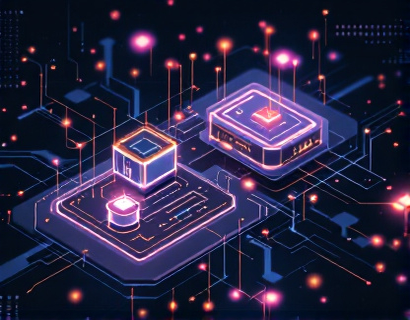Mastering Digital Currency Creation: A Comprehensive Guide to Next-Gen Software for Businesses and Blockchain Innovators
In the rapidly evolving landscape of digital finance, the ability to create and manage digital currencies has become an essential skill for businesses and blockchain innovators. This comprehensive guide delves into the intricacies of digital currency creation, focusing on the advanced software tools that empower users to design, launch, and manage their own digital tokens and currencies with unparalleled customization, robust security, and seamless scalability.
The journey into digital currency creation begins with understanding the fundamental components that make up a digital token or currency. At its core, a digital currency is a cryptographic asset that uses blockchain technology to ensure security, transparency, and decentralization. The blockchain, a distributed ledger, records all transactions across a network of computers, making it nearly impossible to alter or manipulate the data.
To master digital currency creation, one must first grasp the role of smart contracts. Smart contracts are self-executing contracts with the terms of the agreement directly written into code. They automate and enforce the rules and conditions of a digital currency, ensuring that transactions are executed precisely as intended. Platforms like Ethereum have popularized smart contracts, but other blockchain networks such as Binance Smart Chain and Solana also support them, offering varying degrees of flexibility and performance.
Next, consider the importance of choosing the right blockchain platform for your digital currency. Each platform has its own set of features, advantages, and limitations. For instance, Ethereum is known for its robust smart contract capabilities and large developer community, making it a popular choice for complex decentralized applications (dApps). However, it may come with higher transaction fees and slower processing times. On the other hand, platforms like Cardano and Polkadot offer more scalable and cost-effective solutions, with Cardano focusing on research-driven approach and Polkadot emphasizing interoperability between different blockchain networks.
Once the foundation is set, the next step is to design the digital currency itself. This involves defining key parameters such as the total supply, token distribution, and utility. The total supply determines the maximum number of tokens that will ever exist, which can impact inflation and scarcity. Token distribution plans outline how tokens will be allocated among developers, early adopters, and the general public, influencing the currency's adoption and market dynamics. The utility of the token—whether it serves as a medium of exchange, a store of value, or a means of accessing specific services—will dictate its use cases and value proposition.
To achieve unparalleled customization, modern digital currency creation software provides a wide range of configurable options. These tools allow users to tailor the appearance and functionality of their tokens, from designing unique logos and symbols to implementing custom smart contract logic. For example, users can define specific functions for their tokens, such as governance voting, staking rewards, or access to exclusive services. This level of customization ensures that each digital currency meets the specific needs and goals of its creators.
Security is paramount in the world of digital currencies. Advanced software solutions incorporate multiple layers of security to protect against common threats such as hacking, fraud, and unauthorized access. These measures include multi-signature wallets, cold storage options, and regular security audits. Multi-signature wallets require multiple approvals before a transaction can be executed, adding an extra layer of protection. Cold storage keeps a significant portion of the tokens offline, reducing the risk of cyber attacks. Regular security audits by reputable firms help identify and mitigate vulnerabilities in the code.
Scalability is another critical aspect of digital currency creation. As the user base grows, the blockchain must handle an increasing number of transactions without compromising performance. Next-gen software solutions employ various scalability techniques, such as sharding, sidechains, and layer 2 protocols. Sharding involves dividing the blockchain into smaller, more manageable pieces called shards, each processing transactions in parallel. Sidechains allow for off-chain transactions, reducing the load on the main blockchain. Layer 2 solutions, like the Lightning Network for Bitcoin, enable faster and cheaper transactions by processing them off the main chain and settling them later.
For businesses looking to integrate digital currencies into their operations, the software must offer seamless integration with existing systems. This includes API support, wallet integrations, and comprehensive documentation. APIs allow developers to connect their applications to the digital currency platform, facilitating smooth transactions and data exchange. Wallet integrations ensure that users can easily store, send, and receive tokens through popular wallet platforms. Detailed documentation is crucial for developers to understand and implement the software effectively.
For beginners entering the blockchain space, user-friendly interfaces and step-by-step guides are essential. Advanced software should provide intuitive dashboards, clear instructions, and responsive customer support. Tutorials and educational resources can help newcomers grasp the concepts and functionalities, reducing the learning curve. Community forums and developer networks also play a vital role in fostering collaboration and knowledge sharing.
For experts and seasoned blockchain innovators, the software should offer advanced features and customization options. These users often require more control over the underlying code and protocols. Advanced software can provide access to the blockchain's source code, enabling developers to modify and optimize the platform according to their specific needs. Support for custom consensus algorithms, advanced smart contract features, and integration with other blockchain projects can further enhance the platform's versatility.
In addition to technical capabilities, the software should prioritize user experience and accessibility. A well-designed user interface ensures that both beginners and experts can navigate the platform with ease. Responsive design ensures that the platform is accessible on various devices, from desktops to mobile phones. Multi-language support and localized interfaces can help reach a global audience, making the platform more inclusive.
Another important factor is compliance and regulatory adherence. Digital currencies operate in a complex legal landscape, with varying regulations across different jurisdictions. Advanced software should include tools and resources to help creators stay compliant with local and international laws. This may involve integrating know-your-customer (KYC) and anti-money laundering (AML) protocols, providing legal templates, and offering guidance on regulatory requirements.
Finally, the ecosystem around the digital currency plays a significant role in its success. A robust ecosystem includes a vibrant developer community, active user base, and complementary services such as exchanges, payment processors, and merchant integrations. Software that fosters ecosystem growth through partnerships, developer incentives, and community engagement can significantly enhance the currency's adoption and value.
In conclusion, mastering digital currency creation requires a combination of technical expertise, strategic planning, and access to advanced software tools. By leveraging next-gen software that offers unparalleled customization, robust security, and seamless scalability, businesses and blockchain innovators can confidently enter and thrive in the digital finance realm. Whether you are a beginner or an expert, the right tools and resources can streamline the process and open up new opportunities in the exciting world of digital currencies.










































